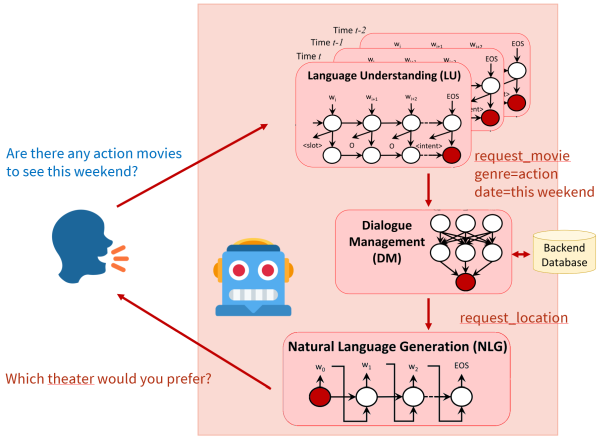This an archived version of the course from the '20/21 Fall semester. Here is the current version.
Statistical Dialogue Systems
Summary
This course presents advanced problems and current state-of-the-art in the field of dialogue systems, voice assistants, and conversational systems (chatbots). After a brief introduction into the topic, the course will focus mainly on the application of machine learning – especially deep learning/neural networks – in the individual components of the traditional dialogue system architecture as well as in end-to-end approaches (joining multiple components together).
This course is a follow-up to the course NPFL123 Dialogue Systems, but can be taken independently – important basics will be repeated. All required deep learning concepts will be explained, but only briefly, so some machine learning background is recommended.
Logistics
The course will be taught in English, but we're happy to explain in Czech as well.
The course will be taught online over Zoom, given the current pandemic. All lectures will be recorded so you can catch up later. Note that recordings of students' voices will not be retained to comply with privacy requirements – don't hesitate to talk in the lectures!
There is a shared Slack workspace for the course – email us to get access.
The schedule is the following:
Lectures + Labs: Tue 9:50-12:10
We start at 9:50 each week – the lab session is not taking place everytime, so sometimes we'll finish earlier.
Zoom meeting ID: 953 7826 3918
Password is the SIS code of this course (capitalized)
If you can't access Zoom, email us or text us on Slack.
To successfully finish this course, you'll need to:
- pass an exam (covering the lectures, especially parts mentioned in the summary) – the exam is either an in-person test or an essay + Zoom discussion (see details on last lecture slides an video, email us if you need video link)
- finish a small lab homework + a big lab project (individual or in groups) – implement some dialogue system experiments and write a report.
Lectures
Slides and from past lectures will appear here (video links are sent directly to students; email us if you want to get video links).
- Introduction (29 Sep)
- Machine Learning Toolkit (6 Oct)
- Data & Evaluation (13 Oct)
- Language Understanding (20 Oct)
- Dialogue State Tracking (27 Oct)
- Dialogue Policy (part 1) (3 Nov)
- Dialogue Policy (part 2) + Language generation (part 1) (10 Nov)
- Language Generation (part 2) (24 Nov)
- End-to-end systems (1 Dec)
- Chatbots (non-task-oriented) (8 Dec)
- Linguistics & Ethics (15 Dec)
- Multimodal Systems (5 Jan) – includes details on the exam
Labs
Lab assignments will appear in the dedicated GitLab repository. There's also videos for the lab instructions (email us to get links).
- 1st assignment – Datasets: deadline 13 Oct for choosing a dataset, 20 Oct for submitting a report
-
Semester projects – implement your own dialogue system/component
- Have a look at project topics (or make up your own) & choose a topic by 10 Nov + write-up in detail by 24 Nov
- Dialmonkey – dialogue framework that we'll use for main assignments
- Have a look at hints for experimenting before you start running your experiments.
- Before you start writing, read these writing guidelines.
Covered topics
-
Brief introduction into dialogue systems
- dialogue systems applications
- basic components of dialogue systems
- knowledge representation in dialogue systems
- data and evaluation
-
Language understanding (NLU)
- semantic representation of utterances
- statistical methods for NLU
-
Dialogue management
- dialogue representation as a (Partially Observable) Markov Decision Process
- dialogue state tracking
- action selection
- reinforcement learning
- user simulation
- deep reinforcement learning (using neural networks)
-
Response generation (NLG)
- introduction to NLG, basic methods (templates)
- generation using neural networks
-
End-to-end dialogue systems (one network to handle everything)
- sequence-to-sequence systems
- memory/attention-based systems
- pretrained language models
-
Open-domain systems (chatbots)
- generative systems (sequence-to-sequence, hierarchical models)
- information retrieval
- ensemble systems
-
Multimodal systems
- component-based and end-to-end systems
- image classification
- visual dialogue
Recommended reading
- Jurafsky & Martin: Speech & Language processing. 3rd ed. draft, Chapter 26
- Gao et al.: Neural Approaches to Conversational AI: Question Answering, Task-oriented Dialogues and Social Chatbots. now publishers 2019.
- Lemon & Pietquin (eds.): Data-Driven Methods for Adaptive Spoken Dialogue Systems. Springer 2012.
- Rieser & Lemon: Reinforcement learning for adaptive dialogue systems. Springer 2011.
- Jokinen & McTear: Spoken dialogue systems. Morgan & Claypool 2010.
- McTear et al.: The Conversational Interface: Talking to Smart Devices. Springer 2016.
- Psutka et al.: Mluvíme s počítačem česky. Academia 2006.
- + current papers from the field


